#classicboats – One of the most significant boats in Irish sailing history is due to be re-launched today after a lengthy restoration. W M Nixon sets the scene, and takes a look at other Irish boat restoration projects on the weekend when the CH Marine Glandore Classics Regatta gets under way in West Cork.
It has been sunny and warm these past couple of days at Belfast and nearby in Bangor. Nevertheless some light showers may go by this morning at the launch site further down the coast when the 38ft yawl Mavis is finally put afloat again. But generally the weather will be gentle for this successful conclusion of a lengthy restoration project which has brought John B Kearney's most famous creation back to full and healthy life.
If that weather seems nothing at all like what they've been experiencing this past week in Belfast and on down the coast at Bangor in County Down, so be it. For we're talking about Bangor and Belfast in Maine USA, where they're snugly on the windward side of our turbulent storm-carrying North Atlantic. And it's on down the sweet and sheltered coast at the picture-postcard little port of Camden that Mavis has been lovingly restored by Ron Hawkins.
Some day we'll recount yet again the story of how a wellnigh perfect performance cruiser, which was created by her designer-builder John Breslin Kearney (1879-1967) in Ringsend in Dublin between 1923 and 1925, has ended up undergoing a restoration over many years in faraway Camden. But just for now, let it be remembered that when John Kearney was the active owner-skipper of Mavis between 1925 and 1952, she was quietly respected by everyone she sailed against in Ireland as an exceptional boat, seakindly yet fast, and a potent performer on the race course.
And she was also admired by discerning visiting sailors such as Humphrey Barton, who was a mustard keen offshore racing and high speed cruising man before he took up ocean voyaging and founded the Ocean Cruising Club in 1954. Barton sailed against Mavis and Skipper Kearney in the Irish Cruising Club's breezy Howth to Peel Race of 1935, and after the doughty little Dubliner had won outright by an impressive margin in style and relative comfort, Barton was so impressed that he contributed an article to Yachting World magazine praising a remarkable seaman and a great boat.

A sailing boat of great power and comfort. Mavis looking just right at a Howth Regatta in the 1940s, with Skipper Kearney at the helm.

Monarch of all he surveys. John Kearney in the companionway aboard Mavis in Dun Laoghaire around 1950, waiting for a breeze to fill in for Saturday afternoon DBSC racing. For the last 21 years of his long life he was a Flag Officer – though by his own choice never Commodore – of the National YC.
But however good she was in her day, Mavis is now ninety years old, and some of those ninety years had seen her neglected and exposed to the elements. So when boat-builder Ron Hawkins of Maine took her on rather more years ago than he now cares to remember, he knew it was going to be a major project with every single piece of timber being a matter of debate as to whether it could be saved or had to be replaced.
On top of that, while John Kearney was on the staff of Dublin Port, first as a shipwright and then effectively as the Harbour Engineer, at least while building his own boat in his spare time it meant he'd a job for life with a set routine and a steady income until retirement in 1944, with a reasonable pension to follow. But a freelance boatbuilder in today's world of jobs-for-the-moment leads an altogether more challenging life, and finding the enthusiasm and resources to go on to work at one's own boat-restoration project, after days and weeks of problems and overtime on somebody else's boat, is not a challenge which could be faced by everyone.

"A lot of work here". Ron Hawkins aboard Mavis at an early stage of his restoration project. Photo: Tim Magennis
Certainly when Tim Magennis, currently Chairman of the Dublin Bay Old Gaffers Association, called by the Hawkins workshop around ten years ago, he found someone who was clearly realizing anew the magnitude of the task he had undertaken. But the entire Mavis project took on a new lease of life three years ago when Denise Pukas joined the team. Ron Hawkins expresses himself beautifully through woodwork, but he's a man of few words. However, Denise brought both encouragement and occasional communication with the many of us on both sides of the Atlantic who were delighted to hear the news that Mavis was finally shaping up to be re-launched on Saturday July 4th 2015, a very special way of celebrating American Independence Day.
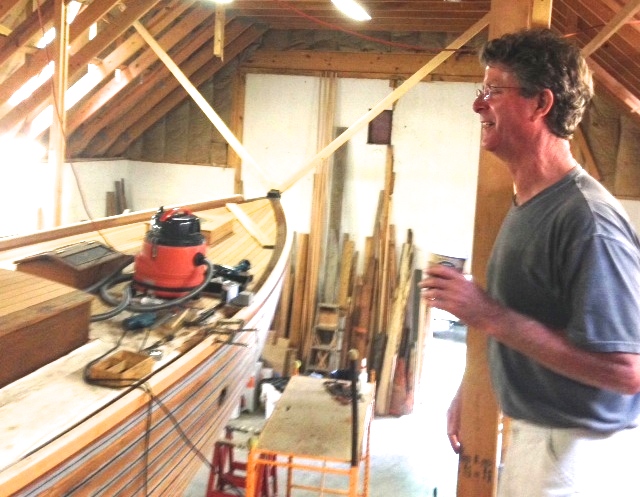
"We're getting there". Ron Hawkins looking more cheerful with Mavis showing definite signs of coming to life two years ago. Photo: Denise Pukas
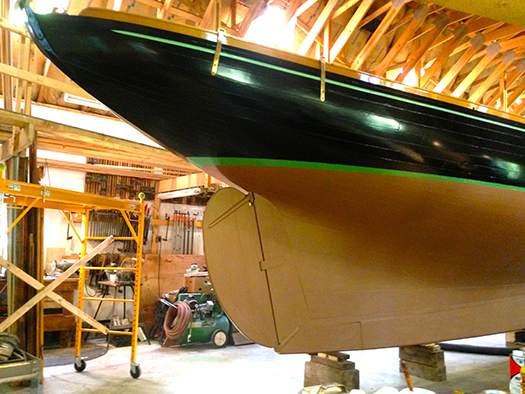
A hint of the beautiful restoration that has been achieved – a glimpse of the elegant stern of Mavis in the Camden workshop this week. Photo: Denise Pukas
But the coldest Spring weather in years in Maine put paid to that hope, yet today – just a fortnight later – Mavis restored will have her splash. It's the latest stage in a long and continuing story. It's a very long way to Camden, Maine from the Ringsend of the 1920s where Mavis was built by John Kearney in a corner of Murphy's Boatyard. But it's truly inspirational that a boat-builder has been able to achieve this when there are always other demands on his time and skills.

Camden near Belfast in Maine is where Mavis has been restored and is due to launch today.

Harry Kernoff's famous woodcut of Murphy's Boatyard in Ringsend captures perfectly the spirit of the place where Mavis was born in 1925.
So we'll return to the Mavis story in the weeks ahead as news comes through from Camden about her first days afloat again. And we'll go on shortly to Glandore, where one of the classic boats being celebrated is another restoration job on his own boat achieved by a popular local boatbuilder.
But for a moment, we'll take a diversion south and west on the other side of the Atlantic, to Negril Beach in Jamaica, where this morning Gary MacMahon and Brother Anthony Keane, directors of the Ilen Boatbuilding School in Limerick and avid followers of everything to do with the great seafarer Conor O'Brien of Foynes, are contemplating the smudges under the emerald blue Caribbean Sea which are the mortal remains of Conor O'Brien's wonderful world-girdling 42ft ketch Saoirse, built in Baltimore in 1922-23.

The recent satllite image of Negril Beach in Jamaica, with the remains of Saoirse marked.
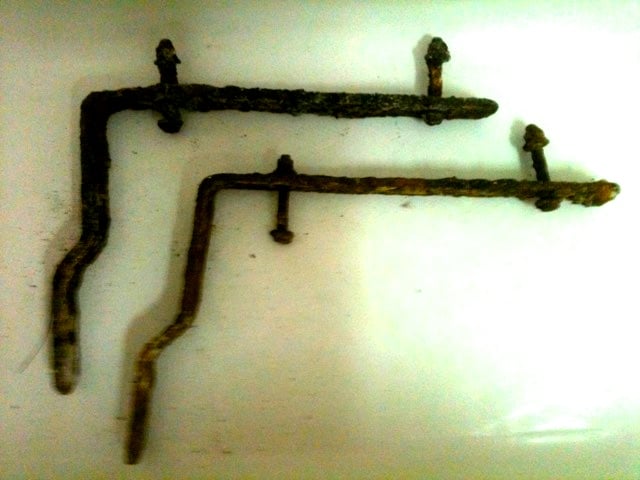
Hanging knees recently retrieved from the Saoirse wreck
Saoirse sank in the aftermath of a hurricane in Jamaica in 1979, but it was local knowledge that surprisingly large pieces of her still survived intact. Most of us reckoned that her timbers would have long since been consumed by the marine borers which abound in the tropical sea. But a recent satellite photo of Negril beach revealed a significant smudge. And then photos were forwarded to the Ilen School of a couple of Saoirse's original iron hanging knees which had been retrieved from the wreck site.
That got people excited, as it was easy to imagine Tom Moynihan's shipwrights installing those very knees all of 93 years ago, though I have to confess to wondering a bit at how the nuts on the retaining bolts seem to be in the outer side of the knees – surely with hanging knees they'd tend to be fastened home on the inner side, with the heads of the bolts counter-sunk in the beams above?
On thinking further about it, for neatness of appearance they'd want the bolt heads on the inside, on top of the visible face of the knee, with the nuts invisibly counter-sunk above. But enough of such quibbles. When those photos were being circulated at the Baltimore Woodenboat Festival on May 22nd to 24th this year, it generated such enthusiasm that an informal Saoirse Rebuild Project was launched there and then. After all, it would fit in very nicely with the fully-restored O'Brien ketch Ilen leaving the shed at Oldcourt as planned next year. So Gary MacMahon was encouraged by everyone in his notion of getting out to Jamaica in July and meeting up with Anthony Bolton, who now lives in California but as owner of Saoirse in 1979, was keen to get together with the Irish duo at Negril beach and help in any way he could.


The model of Saoirse (made by Marine Models of Bray, Co Wicklow) is in Foynes Maritime Museum, and is the most tangible reminder we have of how this remarkable little ship looked in her prime when Conor Obrien circled the globe with her south of the Great Capes
It all sounds straightforward enough, but when you get to Jamaica, you start to see things the Jamaican way. The wreck of the Saoirse is verging on being part of the local heritage along Negril's unspoilt seven mile beach. Perhaps it would be an intrusion and affront to the spirits of the island to think of removing all or any of it. We'll see. But knowing how sensitive Gary MacMahon and Brother Anthony Keane and the Ilen School are to local feelings, we can be sure that whatever is done will be the right thing.
So now to Glandore, where this evening Sean Walsh, International President of the Old Gaffers Association and present in the harbour in his characterful tanned-sail cutter Tir na nOg, will officially open the CH Marine Glandore Classics Regatta 2015, which continues until Friday July 24th, with the larger craft then decamping to Baltimore for the Saturday.
The rugged weather of this year has been tough on the more ancient old gaffers. The exceptionally cold Spring made working on old wooden boats in particular a sometimes impossible task. And then when the season finally got under way on Saturday May 30th, the big annual event in Dublin Bay, the Leinster Plate, was sailed in one of those rising rain-threatening sou'easters which blunt even the most enthusiastic spirits. Still and all, there was a hugely popular win for the ever-keen Denis Aylward with his Cornish Crabber Mona. She may be a plastic fantastic, but Denis has done his duty and more by ancient wooden boats over many decades, and the Leinster Plate is in the right hands.

Mona (Denis Aylmer RIYC), winner of the DBOGA's Leinster Plate 2015. Photo: Dave Owens
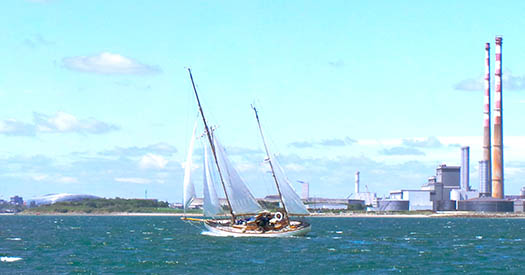
"Poolbeg chimneys and the Aviva Stadium all to be left to starboard......" Darryl Hughes's superbly-restored Tyrrell-built 1937 43ft ketch Mayird on her way to winning the Gaff Rigged Class in Poolbeg Y & BC Regatta 2015
But then a week later, with the Classic Lambay Race lined up to suit the gaffers and the 118-year-old Howth 17s, a day-long westerly gale blew it out. So by July, people had headed off for the sun, and there were only two takers for the Poolbeg Regatta's gaffer division, with Darryl Hughes' beautifully-restored 43ft 1937 Tyrrell-built ketch Maybird taking the honours from the "new" Galway hooker Naomh Cronan.
With the weather that has been in it, it has seemed a long way to get from the Irish Sea to Glandore, but this afternoon Tir na nOg is planning to lead in an OGA flotilla which will have sailed down from Kinsale. Whenever they do get to Glandore, they'll find that the local West Cork fleets of classics and traditional boats will have been augmented by the class of 24.5ft Anglesey Fifes, classic little boats of 1926 vintage from the design board of the great William Fife. They normally race in the Menai Straits, but as they have top-of-the-line road trailers, getting down to Glandore is a much easier proposition than it is for a hefty old Irish Sea-based gaffer.

The Anglesey Fife OD Class – seen here racing in the southern end of the Menai Straits – will be taking part in the Glandore Classics Regatta which starts today
However, for many in Glandore, the interest will mainly focus on a 26-footer which is not gaff rigged and isn't even very old. But she strikes a chord in many hearts because of the people involved in her restoration, the fact that she's a very attractive little boat of a type which deserves to be more numerous in Ireland.
The Stella 26 was designed by Kim Holman in 1959 to form a class at Burnham-on-Crouch in Essex. You could say the design is a Folkboat on steroids, but that is fair on neither boat. So let's just say that the straightforward clinker-built Stella is just that crucial little bit bigger than a Folkboat in all dimensions, which makes her seem quite significantly larger, and she's a delightful boat to sail and be aboard in every way.

(Above and two below) Much more than just a Folkboat on steroids. The 26ft Stella OD, designed by Kim Holman in 1959, is of a size and style which appeals to discerning sailors.
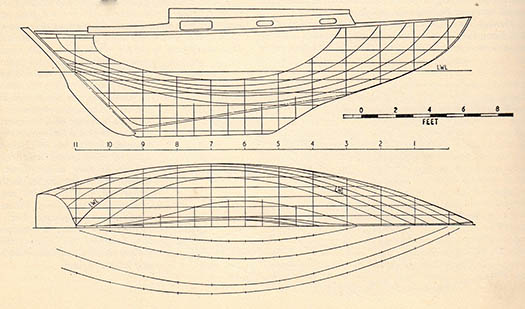

The original notion was that they should sell for 1,100 pounds sterling apiece. But even allowing for today's inflated values, had the restoration of the appropriately-named Stella Happy Return been done as a proper commercial project, she would cost much more than today's version of eleven hundred snots. For the Happy Return is the pet boat of Anke Eckardt and Rui Ferreira, whose wood workshop and boatyard near Ballydehob in West Cork is renowned as a haven for craftsmanship and boat-building of the highest quality, and their work has been seen to good effect in boats as diverse as the Ettes at Castehaven and the Howth 17s, where Rui put a new teak deck on Deiliginis.
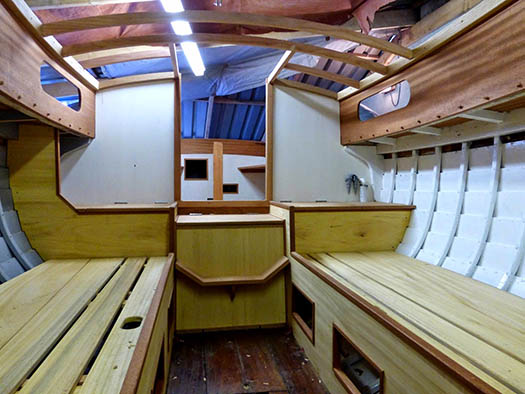
The interior of the restored Stella OD Happy return taking shape in Rui Ferreira's workshop, with clearly more room than you'd get in a Folkboat.
They've had Happy Return as Work in Progress for seven years now, and she was in a very sorry state when they began. But it's only during the past winter that Rui went at it full pelt, putting the boat under a new lean-to roof, and using the unique combination of problems which a clinker-built keelboats provides as valuable casework for his boat-building school.
Once the momentum had gathered pace, things moved steadily on until the re-born Happy Return – better than ever with classy laid decks for the first time, and all the other bells and whistles – was ready for launching three weeks ago. It was an interesting situation, as the AR setup is more accustomed to getting dinghies from its workshop down to the sea than it is to handling keelboats, and even the smallest keelboat will seem enormous in West Cork boreens.
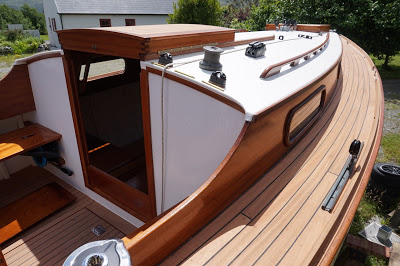
'Tis far from teak laid decks she was reared.... Happy Return was built as an economical standard Stella OD in 1961, but now she is in a different world with teak-laid decks
But it became a neighbourly project with Connie O'Sullivan providing the tractor to move the boat when traffic was quiet on the Sunday morning, then on the wet Monday afternoon the helpful brothers Martin and Liam Whooley at Roaring Water Marine fired up their crane and Happy Return was afloat for the first time anyone can remember in a very long time, her boom draped with an ancient mainsail, for at the moment funds don't run to new sails.
In fact, with sails dating from 1961 and 1975, they reckon they definitely qualify for the traditional division if Glandore Harbour YC feel that a 1961 boat is a doubtful proposition for being a true classic. But I can't imagine that problem arising. Rui Ferreira is one of the best-liked people around boats in West Cork, and the fact that somebody whose working day is taken up with fixing other people's boats can then somehow find the enthusiasm to go to work on his own boat is inspirational, as it has been with Ron Hawkins and the Mavis on the other side of the Atlantic. Happy returns all round.

Rain? What rain? Rui Ferreira with his beloved and beautifully-restored Stella OD Happy Return on a damp Monday afternoon at the end of June, about to be launched at the Whooley brothers' Roaring Water Marine.































































